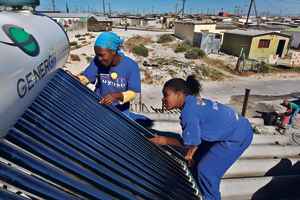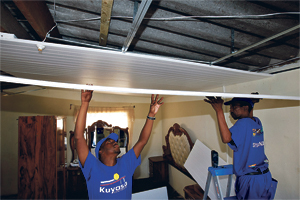Energy efficiency and carbon management award, runner-up: SouthSouthNorth Projects Africa: Kuyasa
[Photos: Kuyasa installs solar water heaters, insulated ceilings and low-energy lighting in RDP houses in Khayelitsha, Cape Town]
As a result of global warming, lowering carbon emissions has become a global prerogative. But the complexities of doing this, weighed against the national growth imperatives of developing economies, has created a perplexing conundrum for governments across the world.
SouthSouthNorth Projects Africa (SSNA), a section 21 organisation based in Cape Town, has set up a project called Kuyasa in collaboration with the City of Cape Town and with funding from the former department of environmental affairs and tourism.
The project installs solar water heaters in Khayelitsha. SSNA is concerned about climate change and how to overcome its effects in vulnerable communities. It aims to use climate change projects and technical innovations to reduce poverty. Through its experience the organisation hopes to guide and influence policy decisions at a national and local level.
The Clean Development Mechanism (CDM) in the Kyoto Protocol allows developing countries to implement carbon reduction initiatives, such as energy-saving projects that can be converted into carbon credits and traded.

Kuyasa , the first registered CDM Gold Standard project in the world, includes the installation of solar water heaters, ceilings and low energy lighting for RDP houses in Khayelitsha.
Until a few years ago many RDP houses were built without ceilings. Not only was this a severe challenge to families when trying to heat or cool their homes, the resulting condensation in the buildings also meant families were living with up to three litres of water dripping on to them and their belongings every day.
‘The lack of proper ceilings and insulation meant that families were spending around R10 a night to heat their homes in winter. The condensation and warm, damp conditions also proved a breeding ground for diseases, especially tuberculosis,” said Carl Wesselink of the South African Export Development Fund and project manager for Kuyasa.
The cost savings amount to about R300 a month and, with about two million RDP houses still without ceilings, the national savings to be gained could be significant. The Kuyasa project has already achieved a total of 6.5 tons of carbon reductions a year, which brings in an income of about R780 000 a year for the project and the local communities.
This does not mean that the improvements are carried out for free. Residents are billed a small amount each month for the improvements but this is offset against the direct income the community is earning as a result of the project.
Labour for the installation is sourced in the community and each head of household is also given a small salary to facilitate the installation and maintenance. The technology that is used is local.
While imported water tanks may be cheaper, the project team at Kuyasa quickly realised that the chlorination in the water, with the high heating temperatures, corroded the stainless steel used in solar water heater products and it has opted for a locally made product which uses a different material. This has not only kept the revenue in the country, but the longevity of the local product has proved to be a long-term cost saving.

The water heaters make use of solar power generators and, despite the vulnerability of these devices, the community is fiercely protective of them, ensuring vandalism is kept to an absolute minimum.
The SNNA is registering a CDM programme for subsidised housing throughout South Africa, based on the suppressed- demand approach used in Kuyasa. Once approved, it will be fast-tracking the rollout of solar water heaters and improved thermal performance to other areas.
The collective benefits from the Kuyasa project have been felt throughout the local community. Direct income generation, improved living conditions, skills transfer and a significant lowering of the area’s carbon emissions have resulted in
net gains for many of Khayelitsha’s most vulnerable inhabitants.